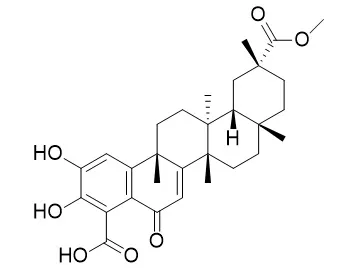| In vitro: |
| Microbiol Res. 2010 Oct 20;165(8):617-26. | | Antibacterial properties of zeylasterone, a triterpenoid isolated from Maytenus blepharodes, against Staphylococcus aureus.[Pubmed: 20116223 ] | The anti-staphylococcal properties of Zeylasterone and demethylZeylasterone, two 6-oxophenolic triterpenoids isolated from Maytenus blepharodes, were investigated.
METHODS AND RESULTS:
Zeylasterone was more active than demethylZeylasterone on Staphylococcus aureus cells, showing bactericidal activity at 30 μg/ml (6 × MIC) in less than three hours and bacteriostatic at lower concentrations. At the same cell density, a more drastic reduction in CFU count was obtained when the triterpenoid was incorporated into cultures growing actively. Zeylasterone at 3 × MIC added on S. aureus cultures showed an early inhibitory effect on incorporation of radiolabeled thymidine, uridina and N-acetyl-glucosamine, and later on leucine. It also caused cell membrane disruption in S. aureus, as shown by the inhibition of radiolabeled precursor uptake, rapid potassium leakage, inhibition of NADH oxidation, and formation of mesosome-like structures around the septa.
CONCLUSIONS:
The structural features of the molecule, the blockage of solute transport through the membrane and changes in its permeability, suggest that Zeylasterone acts mainly on cytoplasmic membrane. | | J Appl Microbiol. 2008 May;104(5):1266-74. | | Activity and mechanism of the action of zeylasterone against Bacillus subtilis.[Pubmed: 18070038] | To investigate the antimicrobial properties of 6-oxophenolic triterpenoids isolated from Maytenus blepharodes against different micro-organisms and the mode of action on Bacillus subtilis.
METHODS AND RESULTS:
The activity of Zeylasterone and demethylZeylasterone was evaluated by microdilution method. Zeylasterone showed a higher activity, being active against Gram-positive bacteria (minimum inhibitory concentration 3-20 microg ml(-1)) and Candida albicans (10 microg ml(-1)). Killing curves revealed a bacteriostatic effect on B. subtilis that was dependent on the growth phase and inoculum size. Zeylasterone caused cell membrane alterations in B. subtilis, as shown by potassium leakage and formation of mesosome-like structures. However, membrane disruption was not revealed by either LIVE/DEAD Baclight assay or measurement of intracellular constituent efflux. Zeylasterone showed an early effect on N-acetyl-glucosamine and uridine incorporation and later on that of thymidine and leucine.
CONCLUSIONS:
Diverse micro-organisms exhibit sensitivities towards compounds studied. The permeability changes in the cytoplasmic membrane and nonsimultaneous ceasing of macromolecular synthesis suggest that Zeylasterone could act on multiple targets on B. subtilis. The activity showed against B. subtilis as a model of spore-forming bacteria would provide valuable information for further studies in the development of 6-oxophenolic triterpenoids as antiseptic and disinfectant properties. |
|






 Cell. 2018 Jan 11;172(1-2):249-261.e12. doi: 10.1016/j.cell.2017.12.019.IF=36.216(2019)
Cell. 2018 Jan 11;172(1-2):249-261.e12. doi: 10.1016/j.cell.2017.12.019.IF=36.216(2019) Cell Metab. 2020 Mar 3;31(3):534-548.e5. doi: 10.1016/j.cmet.2020.01.002.IF=22.415(2019)
Cell Metab. 2020 Mar 3;31(3):534-548.e5. doi: 10.1016/j.cmet.2020.01.002.IF=22.415(2019) Mol Cell. 2017 Nov 16;68(4):673-685.e6. doi: 10.1016/j.molcel.2017.10.022.IF=14.548(2019)
Mol Cell. 2017 Nov 16;68(4):673-685.e6. doi: 10.1016/j.molcel.2017.10.022.IF=14.548(2019)